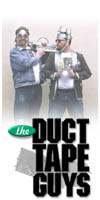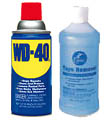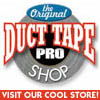

P.S. No, you don't have to ask us permission to use this material for school reports!
![]() Duct tape is a strong tape that is composed of three layers. The top layer (1) is a resilient plastic (Polyethelyne). The bottom layer (3) is a rubber-based adhesive. The middle layer (2) is a fabric mesh.
Duct tape is a strong tape that is composed of three layers. The top layer (1) is a resilient plastic (Polyethelyne). The bottom layer (3) is a rubber-based adhesive. The middle layer (2) is a fabric mesh.  Duct tape was manufactured by pressing these three layers together. Now, some manufacturers have created a process that makes the same strong, three layer tape in just one step. While there are stronger tapes (like filament tape), duct tape, when doubled over onto itself can pull a 2000 lb. car out of a ditch, and has the distinct benefit of not requiring any other tools to cut it - you just rip it with your bare hands.
Duct tape was manufactured by pressing these three layers together. Now, some manufacturers have created a process that makes the same strong, three layer tape in just one step. While there are stronger tapes (like filament tape), duct tape, when doubled over onto itself can pull a 2000 lb. car out of a ditch, and has the distinct benefit of not requiring any other tools to cut it - you just rip it with your bare hands.
In California, to be called "Duct Tape" the tape must meet certain heat-resistant standards - assuming that people will want to use it on ductwork (see below).
Other duct tape-like tapes that don’t recommend use for ductwork are usually called cloth tape or gaff tape (see below).
![]() Duct tape is the quick fix. We (especially in America) want stuff to happen quickly - we lack the patience (and often the skill) to fix stuff right. Plus, this is a throw-away society. We would rather throw something away and buy new than repair and use. If money is tight - repair is the chosen option. The quick repair is duct tape.
Duct tape is the quick fix. We (especially in America) want stuff to happen quickly - we lack the patience (and often the skill) to fix stuff right. Plus, this is a throw-away society. We would rather throw something away and buy new than repair and use. If money is tight - repair is the chosen option. The quick repair is duct tape.
Also - there has been a rise in duct tape awareness thanks to the grass-roots marketing efforts of the Duck® brand company with their popular "Stuck at Prom," "Stuck in Traffic," "Rock the Tape" and other contests and events that utilize duct tape. Red Green (Canadian television comedian - seen on PBS in the U.S.) promotes duct tape to a wierd extent on his show. Garrison Keillor occasionally mentions it on "The Prairie Home Companion." Plus, We've been pushing the stuff in our books and web site since 1994 - that's bound to help.
In general, I think the answer is - everyone knows someone in their family (if not themselves) that uses duct tape to a ridiculous and laughable extent. This makes it a very recognizable and intrinsic part of our popular culture.

![]() Watch a short video of the origins of Duct Tape at the Duct Tape History Theatre.
Watch a short video of the origins of Duct Tape at the Duct Tape History Theatre.
I guess we know about as much as anyone about duct tape origins - so we've become the "experts," or the conveyors of folk lore - as the case may be. It was actually rather hard to find anyone to admit to the actual invention of duct tape. The closest we got to a consistent story was the Johnson and Johnson Revolite Division (until 1953 when it was renamed Permacel) who made the stuff for the U.S. Military during World War II. The original use was to keep the moisture out of the ammunition cases. Because it was waterproof, people referred to the tape as "Duck Tape." Also, the tape was made using cotton duck - similar to what was used in their cloth medical tapes. Military personnel quickly discovered that the tape was very versatile and used it to fix their guns, jeeps, aircraft, etc. After the war, the tape was used in the booming housing industry to connect heating and air conditioning duct work together. Soon, the color was changed from Army green to silver to match the ductwork and people started to refer to duck tape as "Duct Tape." (By the way, "Duck Tape" is now a registered trademark of Duck® brand (a division of ShurTech Brands, LLC) in Avon, Ohio.
WAIT! We just got more information about the origins of duct tape that attributes the original idea to a woman working at an Ordnance Plant in Dixon, Illinois. Read the rest of the story in a special edition of Duct Tape on a Roll.
Adhesive tape (specifically masking tape) was invented in the 1920's by Richard Drew of Minnesota Mining and Manufacturing, Co. (3M). Duck tape (the WWII military version) was first created and manufactured in 1942 (approximate date) by the Johnson and Johnson Revolite (Permacel) Division. Its closest predecessor was medical tape. (No specific person or group of people at Johnson and Johnson have been named in the development of duct tape. Don't ask them... they don't know. But, if you know anything about the origins that we haven't been able to find, let us know!)
Clarification: Johnson and Johnson Permacel Division (originally, Revolite Corporation until 1947 when it was renamed the Industrial Tape Corporation - in 1953 the name was changed to Permacel), were the manufacturers of the original "duct" tape for the military.
![]() We know of at least eight companies in the United States and Canada that manufacture duct tape. Most of the duct tape that is sold into the consumer market is distributed by Duck® brand. Duck® brand Duct Tape is manufactured by Shurtape Technologies in Hickory, North Carolina. Some other duct tape companies are Nashua, 3M, Anchor, Tessa, Tuck, and Polyken.
We know of at least eight companies in the United States and Canada that manufacture duct tape. Most of the duct tape that is sold into the consumer market is distributed by Duck® brand. Duck® brand Duct Tape is manufactured by Shurtape Technologies in Hickory, North Carolina. Some other duct tape companies are Nashua, 3M, Anchor, Tessa, Tuck, and Polyken.
![]() Sure there is! There is a whole line of "plain" colors like red, yellow, green, blue, brown, and black, and now Duck brand® has introduced "Xtreme" colors (like the dayglow colors of the seventies); blaze orange, lime green, citron yellow, and (a favorite of the ladies) hot pink! Duck® brand also has a "Camo Tape" which has a "real tree" camouflage design that is great for hunters and outdoor enthusiasts. There is also a clear duct tape which allows you to fix stuff without seeing the tape (kind of). I like to call it "cameleon tape." Duck brand came out with clear duct tape first, then dropped it from their line-up after sales were less than phenomenal. Later, 3M reintroduced clear tape and made a stir in the market place, so Duck brand brought their brainchild back to the store shelves. Click here for a list of stores that carry colored and clear duct tape.
Sure there is! There is a whole line of "plain" colors like red, yellow, green, blue, brown, and black, and now Duck brand® has introduced "Xtreme" colors (like the dayglow colors of the seventies); blaze orange, lime green, citron yellow, and (a favorite of the ladies) hot pink! Duck® brand also has a "Camo Tape" which has a "real tree" camouflage design that is great for hunters and outdoor enthusiasts. There is also a clear duct tape which allows you to fix stuff without seeing the tape (kind of). I like to call it "cameleon tape." Duck brand came out with clear duct tape first, then dropped it from their line-up after sales were less than phenomenal. Later, 3M reintroduced clear tape and made a stir in the market place, so Duck brand brought their brainchild back to the store shelves. Click here for a list of stores that carry colored and clear duct tape.
Gaff tape (used in the entertainment/movie industry to hold down power and audio/video cords) usually comes in a flat (non-reflective) black color and differs in that the adhesive is removable without leaving a residue. Watch movie credits for the job title "Gaffer" - this is the person who handles and tapes down all of the cords required to make a film/television show.
![]() Yes. As a general rule, spare the cost and spoil the job. Look at the weave of the fabric in the tape. The tighter the weave, the better the tape. Again, Duck® brand Duct Tape is our favorite for consistently good quality tape. But don’t take our word for it, Backpacker Magazine (Oct. 2000 issue) compared different brands of duct tape and gave Duck® brand Tape their highest rating.
Yes. As a general rule, spare the cost and spoil the job. Look at the weave of the fabric in the tape. The tighter the weave, the better the tape. Again, Duck® brand Duct Tape is our favorite for consistently good quality tape. But don’t take our word for it, Backpacker Magazine (Oct. 2000 issue) compared different brands of duct tape and gave Duck® brand Tape their highest rating.
![]() We seldom remove duct tape, so our first thought would be to duct tape over that sticky residue. However, some of you might not go for that solution... so, try spraying the residue down with WD-40 or Duck® brand Adhesive Remover (it has a really nice citrus scent) and let it sit for a bit. The residue should wipe right up. You can also roll duct tape sticky-side-out around your hand and dab up bits of remaining residue. Other products that work to remove the goo are Goo-Be-Gone and rubber cement thinner or acetone.
We seldom remove duct tape, so our first thought would be to duct tape over that sticky residue. However, some of you might not go for that solution... so, try spraying the residue down with WD-40 or Duck® brand Adhesive Remover (it has a really nice citrus scent) and let it sit for a bit. The residue should wipe right up. You can also roll duct tape sticky-side-out around your hand and dab up bits of remaining residue. Other products that work to remove the goo are Goo-Be-Gone and rubber cement thinner or acetone.
Note: We also wrote "The WD-40 Book featuring the uses of WD-40 - the other tool we have in our toolbox. We have two rules to get you through life: If it's not stuck and it's supposed to be, duct tape it. If it's stuck and it's not supposed to be, WD-40 it.
The WD-40 Book is available in The Duct Tape Pro Shop, too.
 On carpets: Try spraying the goo residue down with WD-40 - let it soak for a while, then follow with a spray-in rug shampoo. Let dry and vacuum. Repeat. It eventually does go away. That's why they make Gaffer Tape - to hold rugs and cords down and can be removed without leaving the residue.
On carpets: Try spraying the goo residue down with WD-40 - let it soak for a while, then follow with a spray-in rug shampoo. Let dry and vacuum. Repeat. It eventually does go away. That's why they make Gaffer Tape - to hold rugs and cords down and can be removed without leaving the residue.
On skin: We suggest Tape Remover (shown in the plastic bottle on the left) from Cramer Sports Medicine Solutions. This product deactivates tape residue and adherent, rather than dissolving it. Fast-acting formula replenishes lost oils, moisturizes the skin.
We also got word from an inventive duct tape user that olive oil works well, too. And, olive oil is kind to the skin.
![]() Figure it out yourself. Use this simple rule: If it’s not stuck and it’s supposed to be, duct tape it! People have used duct tape for auto repair, plumbing repair, heat duct repair (really), and even first aid uses! You can read real uses at The Duct Tape Diner.
Figure it out yourself. Use this simple rule: If it’s not stuck and it’s supposed to be, duct tape it! People have used duct tape for auto repair, plumbing repair, heat duct repair (really), and even first aid uses! You can read real uses at The Duct Tape Diner.
![]() Duct tape sticks best to itself (if this happens to you, throw the piece away and start over). Duct tape sticks worst to wet stuff. Make sure that the surface you are sticking to is clean and dry. Duct tape will stick to your skin (better than most bandages/adhesive strips) so it makes a good bandage. Just make sure that the skin is as dry and free of oil as possible prior to adhering the tape.
Duct tape sticks best to itself (if this happens to you, throw the piece away and start over). Duct tape sticks worst to wet stuff. Make sure that the surface you are sticking to is clean and dry. Duct tape will stick to your skin (better than most bandages/adhesive strips) so it makes a good bandage. Just make sure that the skin is as dry and free of oil as possible prior to adhering the tape.
Duct tape by any other name... Click here to read other names given to "duct tape."
Attendance will not be taken and there will be no pop quizzes or final tests in Duct Tape 101. Our goal is to familiarize you with Duct Tape: The Ultimate Power Tool so you can handle all of the little "pop quizzes" that life throws your way.
Buy the Duct Tape Guys' books, videos and Duct Tape apparel at The Duct Tape Guys’ Duct Tape Pro Shop (click the logo)
